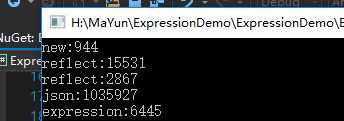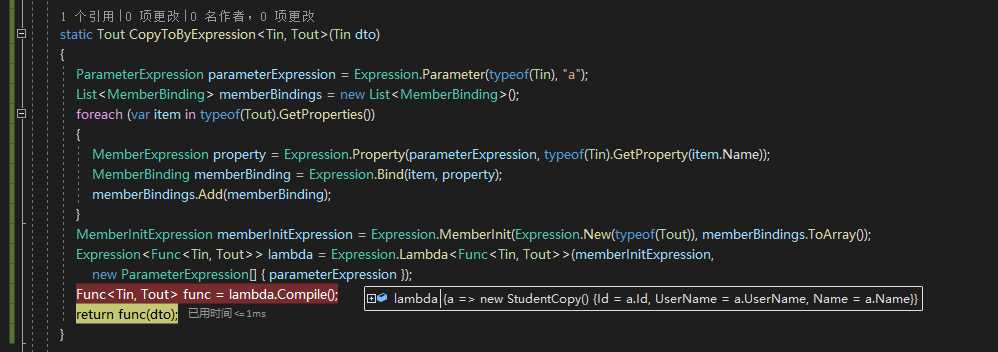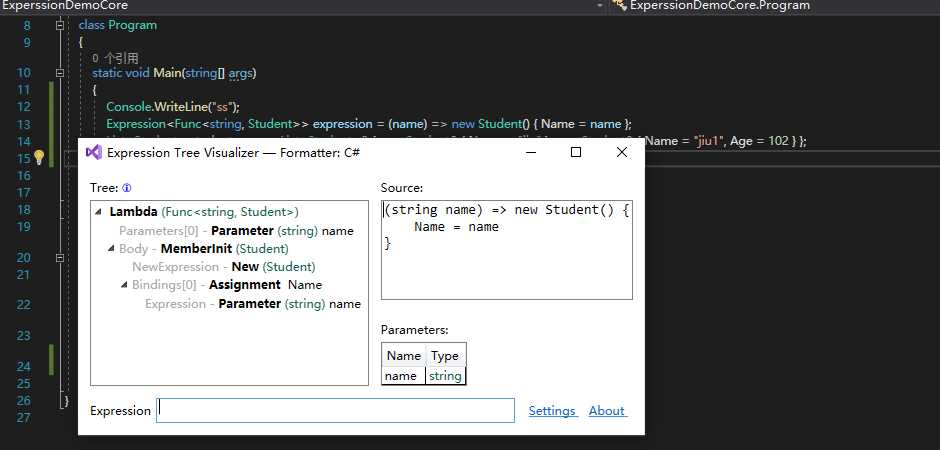.NET Core表达式树的梳理
2021-01-22 23:13
标签:copyto ons 自己 技术 pwa 部分 单行 reac highlight 最近要重写公司自己开发的ORM框架;其中有一部分就是查询的动态表达式;于是对这方面的东西做了一个简单的梳理 官网的解释: 表达式树以树形数据结构表示代码,其中每一个节点都是一种表达式,比如方法调用和 你可以对表达式树中的代码进行编辑和运算。 这样能够动态修改可执行代码、在不同数据库中执行 LINQ 查询以及创建动态查询。 表达式树还能用于动态语言运行时 (DLR) 以提供动态语言和 .NET 之间的互操作性,同时保证编译器编写员能够发射表达式树而非 Microsoft 中间语言 (MSIL) 总结:构造可执行的代码,以树形结构的方式构造; 表达式与委托:委托可以直接执行,而表达式不可以,表达式可以编译成委托 备注:实际上.NET还有以文本的方式构造可执行代码块的方式,但和表达式树还是有区别 我个人工作中主要在以下场景中使用表达式树: 1,代理类方法的构造(如AOP,gRpc,WebService中),通过表达式树,构造委托执行要代理的方法 2,EF,MongoDB,自定义ORM等数据访问层过滤使用的Expression,最典型的就是针对IQueryable类型分页,排序的动态扩展 3,常用的Linq中AND,OR等Predicate加强的一些扩展 4,数学表达式,伪SQL代码的执行解析器的构造(这个比较底层,复杂,更多的是纯数学,数据结构,堆栈,后缀表达式,解析器模式等一些东西) Expression调试工具:2019下载地址ExpressionTreeVisualizer Expression调试工具源码:https://github.com/zspitz/ExpressionTreeVisualizer/blob/master/README.md Expression类有以下属性: Body:表达式的主体(类似于方法体) Parameters:Lambda表达示的参数(参数列表) NodeType:得到树中某些节点的表达式类型(ExpressionType),这是一个有45种不同值的枚举类型,代表表达式节点的所有可能类型,如返回常数、 Type:得到表达式的静态类型 表达式树的几个比较常用的类型/方法,.NET FrameWork与.NET Core在表达式树的使用上做了一些调整 Expression:表达式树核心类,基类;提供了Call,Add等构建Expression的静态方法 Expression.Call():非常核心的一个方法,用于创建调用类的方法的方法类型表达式树;在.NET Core(易用)和.NET FrameWork(易懂)做了些变化 Expression.Parameter():用于创建参数类型表达式树 Expression.Constant():用于创建常量类型表达式树 Expression Expression.Lambda LambdaExpression.Parameters:做表达式树拼接时常用到 LambdaExpression.tailCall:属性,标记是否【尾调优化,参考后面】 创建表达式树的方式(以下示例为.Net Core3.1) 1,以单行Lambda表达式创建表达式树( 包含方法体的Lambda表达式是不能创建表达式树 ); 这种表达式树的构造方式,Lambda表达式实际上是给LambdaExpression的Body(Body为Expression类型)赋值 如果你使用具有方法体的Lambda表达式创建表达式树,是不成功的;表达式树是Lambda表达式的内存中表现形式 2,通过API创建表达式树 创建没有入参和返回参数的表达式树 创建有入参,没有返回参数的表达式树 创建有入参,有返回参数的表达式树 函数尾部调用参数优化:简称尾调优化 1,当函数的最后一步时调用其他函数时,即为尾调;尾调不只是说函数的最尾部;示例,Update,Add方法都是尾部调用 2,LambdaExpression.tailCall属性和Expresssion.Lambda方法中的tailCall参数都是用来标记是否需要尾调优化的, 如果标记尾调优化,则表示当执行进入尾调的函数时,当前函数已经不再依赖父函数上的数据,父函数上的所占用的内存空间将被清空,用于优化节省内存 表达式树动态复制对象: 使用ExpressionTreeVisualizer工具 下载地址:参考前面的地址 安装方式:https://docs.microsoft.com/en-us/visualstudio/debugger/how-to-install-a-visualizer?view=vs-2019#to-install-a-visualizer-for-visual-studio-2019 ExpressionTreeVisualizer工具主要有三个功能 .NET Core表达式树的梳理 标签:copyto ons 自己 技术 pwa 部分 单行 reac highlight 原文地址:https://www.cnblogs.com/cmliu/p/13246185.htmlx 这样的二元运算等。
也可能返回参数、或者返回一个值是否小于另外一个(),或者返回两个值的和( )等等。 //使用单行Lambda创建表达式
static void Expression1()
{
//表达式树的Body
Expression
//错误示例:使用具有方法体的Lambda创建表达式
static void Expression2()
{
//编译不通过,不支持有方法体的Lambda创建表达式
//Expression
//无入参,返参的表达式
static void Expression3()
{
var WriteLine = typeof(Console).GetMethod("WriteLine", new[] { typeof(string) });
//表达式树的Body
var method = Expression.Block(Expression.Call(null, WriteLine, Expression.Constant("来自Expression的输出")));
var action = Expression.Lambda(method).Compile();
action();
}
//有入参,无返参的表达式
static void Expression4()
{
var stringParam = Expression.Parameter(typeof(string), "stringParam");
var WriteLine = typeof(Console).GetMethod("WriteLine", new[] { typeof(string) });
var method = Expression.Block(Expression.Call(null, WriteLine, new[] { stringParam }));
var action = Expression.Lambda
//有入参,有返参的表达式1
static void Expression5()
{
var stringParam = Expression.Parameter(typeof(string), "stringParam");
var WriteLine = typeof(Console).GetMethod("WriteLine", new[] { typeof(string) });
var method = Expression.Block(
Expression.Call(null, WriteLine, new[] { stringParam }),
Expression.Assign(stringParam, Expression.Constant("你好啊"))
);
var action = Expression.Lambda
public int AddUser(string id,string name) {
if (id==null) {
return Update(name);
}
return Add(name);
}
///
class Program
{
static void Main(string[] args)
{
Student student = new Student()
{
Id = 1002,
Name = "哈哈哈",
UserName = "cc"
};
//使用new
Stopwatch stopwatch = new Stopwatch();
stopwatch.Start();
var entity1 = CopyToByNew(student);
stopwatch.Stop();
Console.WriteLine($"new:{stopwatch.ElapsedTicks}");
//使用反射
stopwatch = new Stopwatch();
stopwatch.Start();
var entity2 = CopyToByReflect1



上一篇:基础_02_HTML03
下一篇:程序员接私活的网站